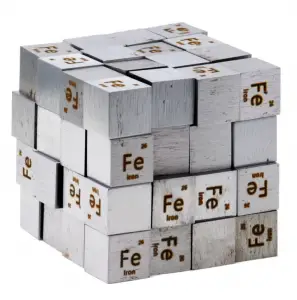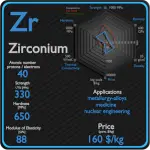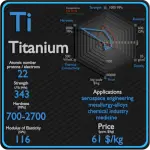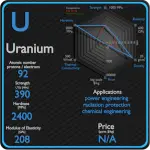This article contains comparison of key thermal and atomic properties of iron and zirconium, two comparable chemical elements from the periodic table. It also contains basic descriptions and applications of both elements. Iron vs Zirconium.

Iron and Zirconium – About Elements


Source: www.luciteria.com
Iron and Zirconium – Applications
Iron
Iron is used in numerous sectors such as electronics, manufacturing, automotive, and construction and building. Iron is the most widely used of all the metals, accounting for over 90% of worldwide metal produc0tion. Its low cost and high strength often make it the material of choice material to withstand stress or transmit forces, such as the construction of machinery and machine tools, rails, automobiles, ship hulls, concrete reinforcing bars, and the load-carrying framework of buildings. Since pure iron is quite soft, it is most commonly combined with alloying elements to make steel. Steels are iron–carbon alloys that may contain appreciable concentrations of other alloying elements. Adding a small amount of non-metallic carbon to iron trades its great ductility for the greater strength. Due to its very-high strength, but still substantial toughness, and its ability to be greatly altered by heat treatment, steel is one of the most useful and common ferrous alloy in modern use. There are thousands of alloys that have different compositions and/or heat treatments. The mechanical properties are sensitive to the content of carbon, which is normally less than 1.0 wt%.
Zirconium
Most zircon is used directly in high-temperature applications. This material is refractory, hard, and resistant to chemical attack. Because of these properties, zircon finds many applications, few of which are highly publicized. Its main use is as an opacifier, conferring a white, opaque appearance to ceramic materials. Zirconium and its alloys are widely used as a cladding for nuclear reactor fuels. Zirconium alloyed with niobium or tin has excellent corrosion properties. The high corrosion resistance of zirconium alloys results from the natural formation of a dense stable oxide on the surface of the metal. This film is self healing, it continues to grow slowly at temperatures up to approximately 550 °C (1020 °F), and it remains tightly adherent. The desired property of these alloys is also a low neutron-capture cross-section. The disadvantages of zirconium are low strength properties and low heat resistance, which can be eliminated, for example, by alloying with niobium.
Iron and Zirconium – Comparison in Table
| Element | Iron | Zirconium |
| Density | 7.874 g/cm3 | 6.511 g/cm3 |
| Ultimate Tensile Strength | 540 MPa | 330 MPa |
| Yield Strength | 50 MPa | 230 MPa |
| Young’s Modulus of Elasticity | 211 GPa | 88 GPa |
| Mohs Scale | 4.5 | 5 |
| Brinell Hardness | 490 MPa | 650 MPa |
| Vickers Hardness | 608 MPa | 900 MPa |
| Melting Point | 1538 °C | 1855 °C |
| Boiling Point | 2861 °C | 4377 °C |
| Thermal Conductivity | 80.2 W/mK | 22.7 W/mK |
| Thermal Expansion Coefficient | 11.8 µm/mK | 5.7 µm/mK |
| Specific Heat | 0.44 J/g K | 0.27 J/g K |
| Heat of Fusion | 13.8 kJ/mol | 16.9 kJ/mol |
| Heat of Vaporization | 349.6 kJ/mol | 591 kJ/mol |





















